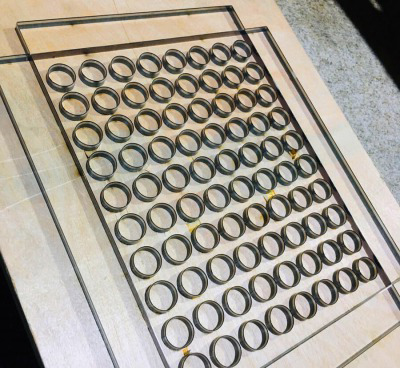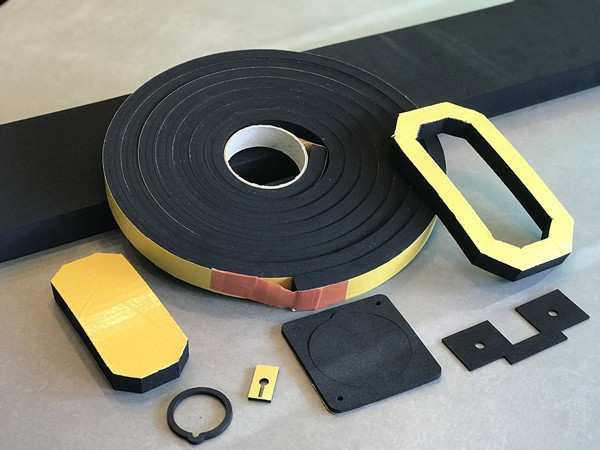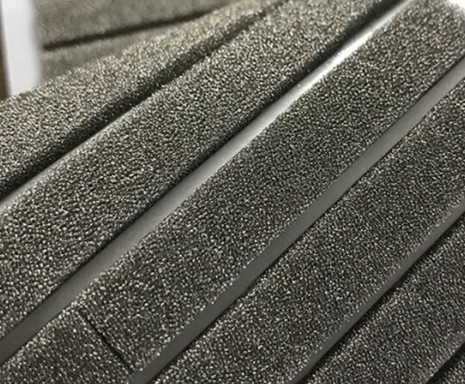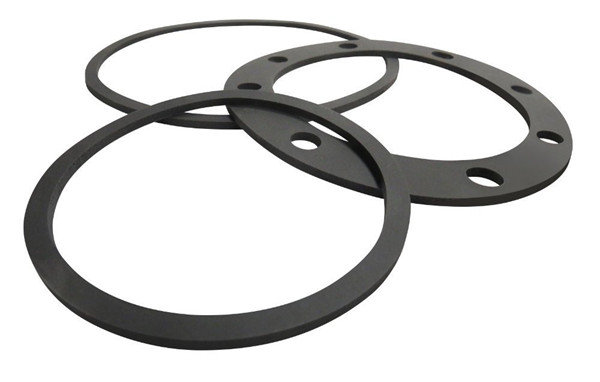With access to a wide variety of foam materials — including both closed cell and open cell foams — foam gaskets (also known as foam seals or sponge gaskets) can be easily customized into different sizes and shapes. Thanks to their excellent properties such as shock absorption, sound dampening, waterproofing, gap filling, and sealing capability, foam gaskets are widely used across numerous industries and applications.
There are several methods available when it comes to foam gasket fabrication. Techniques such as CNC contour cutting, convoluting, injection molding, lamination, and die cutting are commonly used to create a wide variety of foam products.
In this guide, we'll focus specifically on one of the most popular and efficient methods— die cutting. Let's take a closer look at how it works!
Dies are specialized tools used in the manufacturing process to cut or shape materials with precision. Similar to molds, dies are custom-designed to create specific shapes or patterns. They can be used on a wide range of materials, including plastic, wood, felt, fabric, paperboard, and foam.

In most cases, dies are custom-made to meet specific customer requirements. They can be designed to cut almost any shape, pattern, or design, making them highly versatile for producing a wide variety of products. From paperclips and household items to packaging materials, many everyday products are created using die molds. In foam manufacturing, dies are commonly used to produce gaskets, foam inserts, and other custom foam components.
Understanding How Die-Cutting Steel Molds Work
When it comes to foam fabrication, the die-cutting steel mold process is relatively straightforward. It all begins with creating a CAD (Computer-Aided Design) file, which outlines the exact shape, size, and layout of the desired foam product based on the customer's specific requirements.
Once the design is finalized, the foam material is placed into a die-cutting machine equipped with the custom steel mold. The machine then applies pressure to cut the material precisely according to the design. This process allows for the fast and accurate production of custom foam products within seconds.
Common Uses and Applications of Steel Die Cutting

As mentioned earlier, die-cut steel molds are versatile tools used to create a wide range of products. From appliance and automotive parts to foam components and electronic devices, die-cut steel molds are integral to the manufacturing of many everyday items.
While there are various methods for molding parts and products, die-cut steel molds remain one of the most popular choices. This is primarily due to the precision they offer. Since die-cut steel molds are digitally designed, manufacturers can achieve highly accurate cuts consistently with every use of the mold.
Additionally, the die-cutting process is highly adaptable and efficient, making it ideal for producing large volumes of items. Once the mold is created, it takes only seconds to produce each item, allowing for the rapid generation of dozens of products in a short amount of time. In conclusion, if you need to fabricate a mold for a foam product, the die-cut steel mold is an excellent choice. It offers speed, precision, and one of the best values among fabrication processes.
How Foam Gaskets Are Made
Foam gaskets are essential components in many products, providing a reliable seal, especially around doors. They're also commonly used in car engines and lighting. Given their importance, let's explore how foam gaskets function.
What are Foam Gaskets (Sponge Gaskets)?

To begin, let's look at what foam gaskets are. They typically appear as a sponge-like material and are used to create seals, often around doors. To form an effective seal, they need to be molded into the correct shape, which we'll explain how it's done later.
There are several reasons why foam gaskets are used. First, their flexibility allows them to absorb vibrations. They are also effective at blocking environmental factors, such as moisture, chemicals, and sunlight. In some cases, foam gaskets are used to help reduce noise as well.
To understand how foam gaskets achieve these properties, it's important to look at their manufacturing process. A chemical reaction occurs when carbon dioxide gas is combined with other chemicals. As the mixture cools, it solidifies, trapping the bubbles inside. The choice of chemicals is crucial, as it controls the size of the bubbles in the foam, allowing the gasket to be tailored for specific applications.
Introduction to Foam Gasket Applications
Open-cell and Closed-cell Foam Gaskets&Their Industrial Uses
Foam gaskets are a critical component in countless industries and machinery types. Understanding the different foam materials and their manufacturing processes can provide valuable insight into their functionality—and even guide you in crafting custom gaskets for specific needs.
Highly flexible and adaptable, foam gasket materials offer versatile solutions for a wide array of applications. Available in numerous designs and compositions, they provide tailored performance for nearly any requirement. With such a broad selection, finding the right foam gasket for your application is easier than ever.
Today, both open-cell and closed-cell foam gaskets serve an extensive range of industries, delivering reliable and cost-effective solutions to common challenges. Manufacturers frequently turn to foam gaskets to dampen vibrations, protect sensitive components from environmental factors, or ensure airtight seals. Each type—open or closed-cell—has distinct advantages, making them suitable for different specialized uses.
Discover more about the diverse applications of open-cell and closed-cell foam gaskets and how they can enhance performance in your industry.
The Applications of Open-cell Foam Rubber Gaskets

Open-cell foam gaskets, typically crafted from polyurethane foam, offer exceptional versatility. Their unique structure—featuring interconnected, ruptured cells—allows for superior flexibility, enabling them to conform easily to irregular surfaces. Additionally, these gaskets are notably lightweight, making them an ideal choice where weight efficiency is a priority compared to denser alternatives.
Open-cell foam gaskets excel in applications requiring durability and resilience, thanks to their exceptionally low compression set. This means they reliably bounce back to their original shape and thickness even after repeated compression—making them ideal for dynamic environments with frequent movement or vibration.
Because of this outstanding recovery ability, open-cell foam gaskets are commonly used in machinery, electronics, and other systems with moving parts that subject gaskets to constant stress. Their primary role? Absorbing shock, dampening vibrations, and safeguarding sensitive components from the wear and tear of motion. Whether in industrial equipment or consumer products, these gaskets provide long-lasting protection while maintaining their structural integrity.
The Applications of Closed-cell Foam Rubber Gaskets

Closed-cell foam gaskets share the versatility of open-cell foam but with distinct advantages. Unlike their open-cell counterparts, they may not fully rebound after prolonged compression—yet they compensate with greater durability and structural rigidity.
A standout feature of closed-cell foam is its natural water resistance, making it a top choice for outdoor applications or products exposed to harsh weather. This moisture-blocking capability ensures reliable performance in demanding environments, from industrial machinery to construction seals, where protection against the elements is critical.
Unlike open-cell foam, closed-cell foam is typically made from specialized materials like crosslinked polyethylene foam (XLPE), PVC foam, or nitrile foam—each chosen for their unique properties that enhance performance. These dense, impermeable materials excel at creating tight seals, effectively blocking out dust, debris, moisture, and harsh weather conditions.
The primary role of closed-cell foam gaskets is isolation and protection. Whether sealing sensitive electronics, industrial enclosures, or outdoor equipment, they provide a durable barrier against environmental hazards, ensuring long-term reliability in demanding applications.
Sponge Gaskets Used in Various Industries
Foam gaskets serve critical functions across countless industries, with applications so diverse it would be impossible to name them all. Some of the most prominent sectors relying on these versatile components include:
●Automotive: Sealing doors, hoods, and electronic components
●Lighting & Electronics: Protecting sensitive devices from dust and moisture
●HVAC Systems: Ensuring airtight insulation in ductwork and units
●Household Appliances: Providing noise reduction and vibration damping
●Medical Equipment: Maintaining sterile, sealed environments for devices and tools
From heavy machinery to precision instruments, foam gaskets deliver essential protection and performance enhancements across manufacturing and technology sectors.
In summary, the gaskets discussed represent just a fraction of the diverse options available today. The market offers an extensive array of gasket types, ranging from traditional foam varieties to advanced designs utilizing silicone, neoprene, and other specialized materials. Each material and configuration serves unique purposes, ensuring optimal performance across countless industrial and commercial applications. With continuous innovation in materials science, gasket technology continues to evolve to meet increasingly demanding operational requirements.
English
العربية
Français
Русский
Español
Português
Deutsch
italiano
日本語
한국어
Nederlands
Tiếng Việt
ไทย
Polski
Türkçe
ភាសាខ្មែរ
Bahasa Melayu
ဗမာစာ
தமிழ்
Filipino
Bahasa Indonesia
magyar
Română
Čeština
қазақ
Српски
हिन्दी
فارسی
Kiswahili
Norsk
Svenska
українська
Ελληνικά
Suomi
עברית
Latine
Dansk
اردو
বাংলা
Afrikaans
नेपाली
Oʻzbekcha
Azərbaycan dili
Български
guarani
Hausa
Kurdî
Kurdî
Lietuvių
Wikang Tagalog
isiZulu


 As mentioned earlier, die-cut steel molds are versatile tools used to create a wide range of products. From appliance and automotive parts to foam components and electronic devices, die-cut steel molds are integral to the manufacturing of many everyday items.
As mentioned earlier, die-cut steel molds are versatile tools used to create a wide range of products. From appliance and automotive parts to foam components and electronic devices, die-cut steel molds are integral to the manufacturing of many everyday items. 

 Closed-cell foam gaskets share the versatility of open-cell foam but with distinct advantages. Unlike their open-cell counterparts, they may not fully rebound after prolonged compression—yet they compensate with greater durability and structural rigidity.
Closed-cell foam gaskets share the versatility of open-cell foam but with distinct advantages. Unlike their open-cell counterparts, they may not fully rebound after prolonged compression—yet they compensate with greater durability and structural rigidity. 
